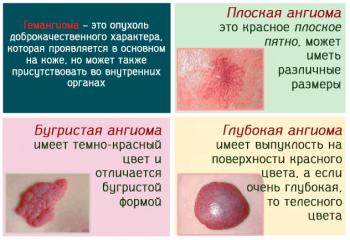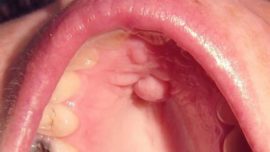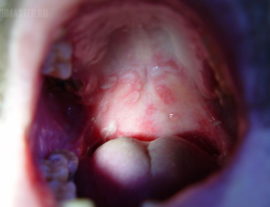Pine cone in the mouth: types, causes, diagnosis and treatment
The growth on the mucous membrane of the mouth located in the upper palate causes discomfort in the wearer, sometimes accompanied by pain. A pine cone in the mouth arises from several completely different diseases. Each disease has its own characteristics and causes, but their clinical characteristics are similar. Without the qualified help of a doctor, it is impossible to determine an accurate diagnosis and an effective method of therapy.
Content
Types of tumor
A tumor in the mouth in the sky always indicates the onset of the inflammatory process in the human body. Tumors are benign and malignant.
Malignancy
Problems with the development of a malignant tumor are not limited to disturbances in speaking and eating. A lump caused by cancer disrupts articulation, complicates the ability to communicate, or completely eliminates it.
Oral cancer is characteristic of men and is a local metastasis of other malignant tumors in the head. It is a rare cancer.
Such malignant seals are classified as an outgrowth in the mouth of the palate. A tubercle can jump up due to a benign inflammatory process, therefore an unequivocal opinion about the diagnosis cannot be popped up.
Understanding the causes of a neoplasm is important for determining the course of treatment. It is possible to accurately diagnose the causes by conducting clinical studies of compaction.
Benign education
A cyst in the mouth is not a fatal diagnosis, it is diagnosed with a number of benign tumors. Such tubercles are caused by insidious, but treatable diseases:
- growth of tissue of blood vessels (angioma);
- cyst;
- pemphigus (erosion);
- mixoma.
Preliminary determination of bump symptoms
A lump in the palate is the cause of a dental disease or inflammation. Each type of growth has its own causes and subtleties of symptoms, therefore it requires a separate consideration.
Angioma
Angioma - a tumor in the sky caused by a violation of the processes in the tissues of the blood vessels of the soft palate. The shape of the cone resembles a rolled corkscrew. The tubercle has a blue or crimson-black, characteristic color. The ball is a product of a violation of the development of blood vessels, so the color is caused by excess blood in the formation.
Pressure causes bleeding, which is not necessary to experiment with. Is present pulsating reaction to pressing.
Such a lump in the upper palate is life threatening to the patient. Bleeding is difficult to stop, and a large loss of blood is fatal.
At the first sign of such a seal, you must seek qualified help.
Cyst
A lump in the mouth in the sky is classified as a cyst, when a hard ball jumps up in the sky and its size does not exceed 12 cm. A cyst appears due to the disruption of the sebaceous glands. She will not be ill, but it will significantly complicate the ingestion of food, and then she will finally violate the correct operation of these secrets.
A cyst in the sky requires surgical intervention and is treated only by him.
Pemphigus
Most of all, children are susceptible to pemphigus. She jumps up in the shape of a white ball in the upper part of her mouth. Cones are the result of erosion, later develop into ulcers. When pressed, bleeds and hurts. Diagnosed by visual inspection and the method of Nikolsky.
If the tumor is not removed, erosion will develop into massive exfoliation of the epithelium of the oral cavity, impaired digestion, general weakness. If there is no treatment, the cones become massive. Pressure causes the rupture of tumors, the contents of which cause intoxication of the body.
Myxoma
Myxioma is a solid growth of white in the upper part of the mouth. The disease affects the hard part of the palate, and with a visual examination it is almost imperceptible, pressure on the tumor is not felt. This significantly complicates the diagnosis and delays the patient's visit to the doctor.
Confirm or deny the diagnosis by biopsy of the sky.
Oncological disease
The cancer cone is classified by two diseases:
- Hard palate cancer - starting with bone tissue between the nasopharynx and palate, the disease spreads to all the tissues of the mucosa.
- Soft palate cancer - a lump appears due to an oncological process in the muscle and mucous membranes of the mouth.
Additionally, an oncological tubercle in the mouth is divided into tissues along the tissue with which the spread of the disease began:
- Cylindrome - maternal tissue is the tissue of the glands, the cancer spreads quickly and captures the oral cavity;
- Adenocarcinoma - begins the expansion of the mouth from the soft tissues of the cavity;
- Squamous cell carcinoma is a malignant formation that begins with mucosal tissue development.
Prerequisites for the occurrence of cones
A complete list of reasons for which bumps may appear is not formed by modern medicine. The reasoning of doctors is based on hypothetical causal relationships. The cones in the sky lead to:
- Bad habits (smoking, alcohol, oral narcotic substances);
- The presence of micro and macro injuries of the oral cavity (surgery, scratches of the upper parts of the oral cavity);
- The presence of dentures;
- Viral infections;
- Intrauterine disorders (hemangioma is a congenital disease and is acquired from the mother);
- Violation of the activity and integrity of the mucous membrane (characteristic of angina);
- Congenital and acquired disruption of the glands (the main cause of cysts).
For the appearance of malignant tumors, two more hypothetical reasons are distinguished:
- Eating too hot and spicy food, constantly violating the structure of the cells of the oral cavity;
- The presence of papillomatosis or leukoplakia - diseases that are precancerous cones that can develop into an oncological disease.
Diagnostic Methods
To determine the method by which a lump in the mouth will be treated in heaven, the causes of its occurrence are studied. The diagnosis procedure is carried out by the dentist.
A regular visit to the dentist is important to prevent the disease and determine that a lump has appeared in the sky. It is necessary to treat it at an early stage.
For diagnosis, use:
- Roentgenography;
- Biopsy
- Blood analysis;
- Radioisotope study;
- Ultrasound
If you comprehensively study the balloon in the mouth in the sky, this will confirm or deny the presence of a malignant formation, and if it is absent, it will determine the exact diagnosis of benign.
Cone treatment
The methodology of treatment depends on the specific case. The approach is determined by:
- the presence of pain;
- part of the cavity exposed to infection (upper, lower);
- time elapsed since the onset of the disease;
- the reaction of the bump to pressure.
Angioma treatment
This type of cone removal occurs in three stages:
- Drug treatment and treatment;
- Surgical intervention;
- Radiation therapy.
At the first stage, alcohol is used: it narrows the blood vessels and helps to eliminate high blood loss during surgery.
After that, in the case of the capillary form, radium therapy is used, it consolidates the effect of treatment, and sometimes it can act as an independent drug and cure the disease completely.
Cavernous form of angioma should not be treated with radium. It can contribute to the conversion of the lump into malignant, which greatly worsen the patient's condition.
Pemphigus treatment
A bump of this type that has arisen in the sky is treated mainly with antibiotics and a diet that includes a high content of proteins and vitamins, but without salt.
If a similar bump appears, it is necessary to use disinfectant solutions. In severe forms, a blood transfusion is used.
Treatment of myxoma and cysts
With these forms of the disease, the attending physician prescribes antiseptic drugs and prepares the cavity for surgical intervention (in case there are signs of accelerated germination of the cone in the tissue).
They also use additional methods of electrical treatment, which allow artificially killing tissues without using a scalpel, but all methods of this type are dangerous, thanks to them, a malignant formation may appear in place of a benign one.
Oncological treatment
Cancer requires the immediate intervention of a qualified professional. The earlier the stage of the disease, the less harm the body and the disease will cause. If an oncological cone jumps up, the following approaches are used in treatment:
- Radiation therapy - cancer is irradiated with x-rays. In the early stages, the disease is completely cured.
- Surgical intervention - not only a malicious cone is cut out, but also the tissues around it, in order to exclude relapses. Such an intervention leaves defects on the face, which can later be corrected by plastic surgery.
- Chemotherapy - taking cytostatics.
With the oncological disease under consideration, chemotherapy is effective only in combination with the radiation method and surgery.
Any disease is easier to defeat at the stage of origin. But in the case of bumps in the sky, it is better not to have the disease than to treat it later.
The root causes of the ailment are not fully established. Therefore, the implementation of rules formed hypothetically will not protect you from the disease completely, but it will definitely reduce the chance of having a similar problem. A preventive visit to the dentist will provide treatment in a timely manner, even if the lump jumps up unnoticed.








